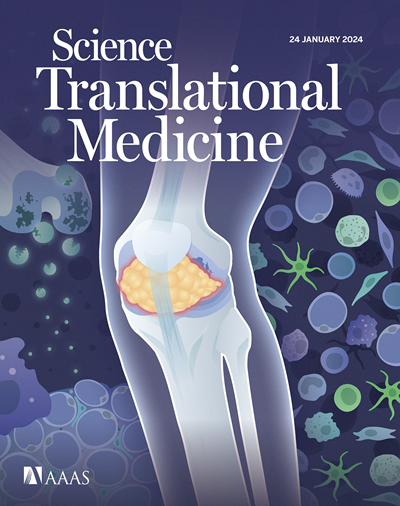Activation and targetability of TYMP–IL-6–TF signaling in the skin microenvironment in uremic calciphylaxis
IF 15.8
1区 医学
Q1 CELL BIOLOGY
引用次数: 0
Abstract
Calciphylaxis is an orphan disease characterized by dermal microvessel thrombosis, inflicting painful cutaneous necrosis. It occurs predominantly in patients with end-stage kidney disease and has high mortality, elusive pathogenesis, and no approved therapies. We demonstrate that sera from patients with calciphylaxis induced de novo synthesis of interleukin-6 (IL-6) and soluble IL-6 receptor (IL-6R) and stimulated Janus kinase-2 (JAK) and signal transducer and activator of transcription (STAT)–3 phosphorylation in primary human dermal microvascular endothelial cells (ECs). Calciphylaxis skin demonstrated an altered microenvironment characterized by a gain of proximal and distal IL-6 ligand-receptor interactions. Microvessels are the predominant senders and recipients of IL-6 signaling, which, along with up-regulated A disintegrin and metalloproteinase 17 in dermal vasculature and interstitial IL-6R, supported trans–IL-6 signaling in calciphylaxis lesions. Calciphylaxis serum up-regulated thymidine phosphorylase (TYMP) in ECs. TYMP up-regulated IL-6, which activated tissue factor (TF), a primary trigger of the extrinsic coagulation cascade. IL-6–TF signaling in ECs was partially triggered by elevated IL-6 and kynurenine amounts in calciphylaxis serum and was inhibited by anti–IL-6 treatment. The TF-inducing ability of calciphylaxis serum is correlated with disease activity and response to IL-6 inhibitors in ECs. Calciphylaxis is therefore a combination of serum-inducing TYMP–IL-6–TF signaling in ECs and a heterogeneous permissive local dermal microenvironment. The latter is characterized by microvessels initiating IL-6 signaling and multiway cross-talk with adipocytes and eccrine glands, perpetuating the sinister thrombotic milieu. Our results support exploring the IL-6–TF–inducing ability of calciphylaxis serum as an activity marker and IL-6 as a therapeutic target for uremic calciphylaxis.
尿毒症钙化反应中皮肤微环境中TYMP-IL-6-TF信号的激活和靶向性
钙化病是一种孤儿病,其特点是真皮微血管血栓形成,造成疼痛的皮肤坏死。它主要发生在终末期肾病患者身上,死亡率很高,发病机制难以捉摸,也没有获得批准的疗法。我们的研究表明,钙皮病患者的血清会诱导白细胞介素-6(IL-6)和可溶性 IL-6 受体(IL-6R)的从头合成,并刺激原代人真皮微血管内皮细胞(ECs)中的 Janus 激酶-2(JAK)和信号转导及转录激活因子(STAT)-3 的磷酸化。钙化性皮肤表现出微环境的改变,其特点是近端和远端 IL-6 配体-受体相互作用的增加。微血管是IL-6信号的主要发送者和接收者,这与真皮血管中上调的A崩解素和金属蛋白酶17以及间质IL-6R一起支持了钙化病皮损中的反式IL-6信号。钙化血清可上调血管内皮细胞中的胸苷磷酸化酶(TYMP)。TYMP上调IL-6,IL-6激活组织因子(TF),TF是外凝血级联的主要触发因子。钙磷血清中升高的IL-6和犬尿氨酸可部分触发心血管细胞中的IL-6-TF信号转导,抗IL-6治疗可抑制这种信号转导。钙磷血清的TF诱导能力与疾病活动和心肌细胞对IL-6抑制剂的反应相关。因此,钙化病是血清诱导 EC 中的 TYMP-IL-6-TF 信号转导和异质性的局部皮肤微环境共同作用的结果。后者的特点是微血管启动 IL-6 信号,并与脂肪细胞和皮脂腺进行多向交叉对话,使险恶的血栓形成环境得以延续。我们的研究结果支持将钙血症血清中的 IL-6-TF 诱导能力作为一种活性标志物,并将 IL-6 作为尿毒症钙血症的治疗靶点。
本文章由计算机程序翻译,如有差异,请以英文原文为准。
求助全文
约1分钟内获得全文
求助全文
来源期刊

Science Translational Medicine
CELL BIOLOGY-MEDICINE, RESEARCH & EXPERIMENTAL
CiteScore
26.70
自引率
1.20%
发文量
309
审稿时长
1.7 months
期刊介绍:
Science Translational Medicine is an online journal that focuses on publishing research at the intersection of science, engineering, and medicine. The goal of the journal is to promote human health by providing a platform for researchers from various disciplines to communicate their latest advancements in biomedical, translational, and clinical research.
The journal aims to address the slow translation of scientific knowledge into effective treatments and health measures. It publishes articles that fill the knowledge gaps between preclinical research and medical applications, with a focus on accelerating the translation of knowledge into new ways of preventing, diagnosing, and treating human diseases.
The scope of Science Translational Medicine includes various areas such as cardiovascular disease, immunology/vaccines, metabolism/diabetes/obesity, neuroscience/neurology/psychiatry, cancer, infectious diseases, policy, behavior, bioengineering, chemical genomics/drug discovery, imaging, applied physical sciences, medical nanotechnology, drug delivery, biomarkers, gene therapy/regenerative medicine, toxicology and pharmacokinetics, data mining, cell culture, animal and human studies, medical informatics, and other interdisciplinary approaches to medicine.
The target audience of the journal includes researchers and management in academia, government, and the biotechnology and pharmaceutical industries. It is also relevant to physician scientists, regulators, policy makers, investors, business developers, and funding agencies.
 求助内容:
求助内容: 应助结果提醒方式:
应助结果提醒方式:


